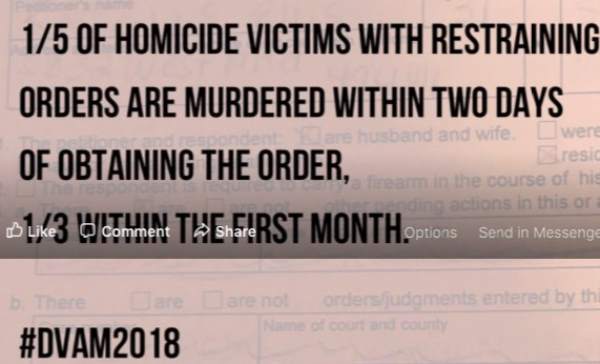A 2008 study reported that 20 percent of victims of Intimate Partner Homicide who had restraining orders were killed within two days of obtaining those orders.
The study also found that just 11 percent of IPH victims overall had restraining orders in place at the time they were killed.
With October marking Domestic Violence Awareness Month in the U.S., readers contacted us regarding a graphic circulating online sharing an alarming statistic regarding homicide rates for partners who obtained restraining orders.
The graphic, which was unattributed but bore the hashtag #DVAM2018, read as follows:
1/5 of homicide victims with restraining orders are murdered within two days of obtaining the order,
1/3 within the first month.
The figures were taken from a 2008 study regarding intimate partner homicides (IPH). Although the data presented in the meme was accurate, it lacked some context provided by the original source and therefore could be potentially misleading when taken in isolation.
According to that study:
About 11% of 231 women killed by male intimates had been issued a restraining order. About one-fifth of the female IPH victims who had a restraining order were killed within 2 days of the order being issued; about one-third were killed within a month. Nearly half of those with a restraining order had been protected by multiple orders. Victims killed in a shared residence (versus elsewhere) had lower odds of having a restraining order, whereas victims from rural (versus urban) counties, married (versus dating) victims, and Latino (versus non-Latino) victim-offender dyads had higher odds of having a restraining order. The type of weapon used was not associated with whether the victim had been under the protection of a restraining order.
While the numbers used in the meme were quoted accurately, we are rating this item as a Mixture because it doesn't mention that the overwhelming majority of IPH victims reported by the survey who were killed by intimates (89%) did not have restraining orders in place. Omitting this piece of information could create a false impression regarding the effectiveness of restraining or protective orders, and more recent data supports their use as a deterrent against intimate partner violence.
A 2011 study published by the Carsey School of Public Policy at the University of New Hampshire found that the quality of life improved for the 213 women they surveyed who had received civil protective orders. Half the women reported that the orders were not violated, and the majority of respondents reported declines in "days of distress and sleep loss" after obtaining those orders.
The report concluded by noting:
Not only are civil protective orders effective, but they are relatively low cost, especially when compared with the social and personal costs of partner violence. The effectiveness is particularly relevant for low-income rural women. These women had more personal and social barriers to stopping the violence including higher unemployment and tighter connections to the violent partner. Rural women also had fewer community resources or alternatives available to help them. Therefore, increasing access to civil protective orders should be an important goal in helping victims and their children and in lowering societal costs of partner violence.
We contacted Katherine Vittes, the lead researcher for the 2008 study cited in the meme, seeking comment but did not receive a response prior to publication.


